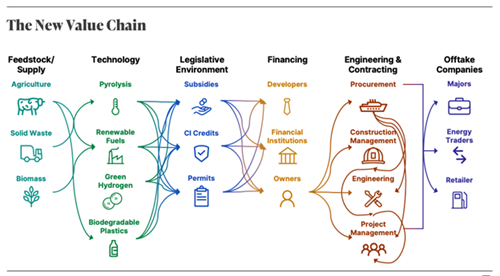Managing the new risk profile of energy transition projects
The time is ripe to realize the vision of a clean energy future. However, that future comes with new risks. In the old era of vertical energy integration, a few companies controlled the value chain—from crude oil to product retail. Major energy companies owned the oil and gas in the ground and their own processing technologies, and they exerted major influence over the regulatory process. They had a balance sheet to pay for their projects, worked with their favorite engineering, procurement and construction (EPC) firms, and owned the retail organization to distribute products to consumers (FIG. 1).

The new value chain is comprised of stakeholders that historically did not work together. Instead of crude oil, feedstocks are sourced from nature, agriculture and waste management companies. Each of these processes requires novel and adapted technologies offered by different vendors with competing guarantees. Early economic incentives exist, but the legislative environment fluctuates. Developers with little experience in major complex projects must now navigate financing challenges, conflicting EPC approaches and entrenched product retailers.
All these factors add up to a new project risk profile. The three most critical areas in a project are project definition, technology selection and stakeholder requirements (FIG. 2).

Project definition
Projects in the new value chain must optimize three inputs in project definition: business model, financing strategy and viable technology (FIG. 3). Aligning only two of these inputs will not result in a successful project.

First, a sound business model must be established. In addition to balancing feedstock and the product market, a sound business model requires favorable yield structures, balanced operating costs and a realistic total installed cost. To wrap it all up, the money must be available to pay for the project, whether it is debt, equity, cash flow or a combination of all three.
Technology selection
Project definition will drive technology selection, and the chosen technology path will impact carbon intensity. There are many technology choices and competing technologies may meet the same project goals. For example, at least four competing hydroprocessing-based technologies produce renewable diesel from vegetable oils and animal fats, and there are at least three feed pretreatment options. Similarly, multiple paths exist for plastics recycling—both mechanical and chemical processes, such as pyrolysis. Technology selection is a key part of project development, with the right choice leading to success and the wrong choice leading to failure.
As with anything untried, novel technologies introduce risk. However, with risk comes the potential for reward. Conducting detailed due diligence, taking the time to understand technology and negotiating guarantees will mitigate some of this risk.
Stakeholder requirements
Today’s sustainable projects have new stakeholders that may have never executed a complex project: financial institutions, project developers and startups. These stakeholders may lack a nuanced knowledge of technology, schedule or escalating costs, which means risk. With risk comes the need for guarantees from the technology provider and EPC firms. These can be guaranteed as lump-sum pricing or an overall financial and technical wrap. This passes risk on to the EPCs, who are not always willing to accept the risk; other stakeholders, including banks and owners, may have to contribute more equity.
Stakeholders need to understand the importance of efficient execution and achievable schedules in meeting deadline-critical government incentives. The historical project scheme may not be acceptable in today’s world, where time to market is critical. Compressed engineering schedules can shorten the engineering time and help identify long-lead equipment early in the design engineering phase. A fast-track project will require overlap in the front-end loading (FEL)-2 and FEL-3 phases and in detailed design and construction.
Takeaway
Energy transition projects have a fragmented value chain, competing and new stakeholders, and a complex technology selection process. Project risk can be reduced, and return on investment (ROI) maximized with accurate project definition, compressed delivery schedules and expert management.
Two essential factors drive energy transition projects:
- Owner integration: Projects must be developed and executed with all stakeholders aligned behind the asset owner’s business goals, objectives and priorities. The best way to accomplish this is through a project leadership team deeply integrated with the owner, working as one team and helping to build the project organization in alignment with owner goals. Traditional and non-traditional stakeholders and the integrated project management team (IPMT) must work together, seamlessly. IPMTs have achieved remarkable project success, and this success should continue globally.
- Expertise: Project leadership teams must be composed of highly experienced, multi-disciplined project professionals who can address the nuanced complexities of a project—in essence, providing the right people at the right time. Key decisions must be made in a timely manner. Setting the design basis, understanding the technology and its requirements, and managing the supply chain are key. GP
Mickey Reeves, Vice President of Project Development, TritenIAG, shares the expertise gained from more than 30 yr in the capital projects industry.




Comments